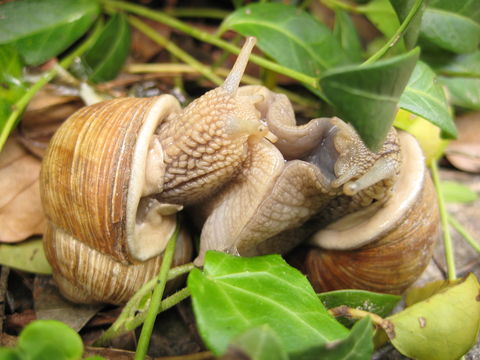
Reproduction
Since this particular species of snail has not been
extensively studied, there have not been many discoveries on the
exact means of reproduction specifically regarding the snail.
However, classification is broadened to the class Gastropoda,
subclass Pulmonata, some general statements can be made about
the reproduction of snails in this classification.
Gastropod Pulmonate snails are monoecious, literally meaning
“one house” (Encyclopedia Britannica,
2012). This simply means that
the snail is hermaphroditic or contains both male and female
reproductive parts in one body or “house”
(Encyclopedia Britannica, 2012).
Pulmonate Gastropods (Image by Encyclopedia of Life)
 Some
Pulmonates engage in courtship as a step before mating.
Courtship is when animals use visuals, actions, chemicals, or scents
to attract a mate (Encyclopedia Britannica,
2012).
This way they can distinguish between their species and other
species to ensure successful mating
(Encyclopedia Britannica, 2012). These Pulmonates transfer sperm by
inserting the penis of the snail acting as a male into the snail
acting as a female (Encyclopedia
Britannica, 2012). This is called internal fertilization and when the
female is ready to lay the eggs, she lays them in places like the
grooves of the shell or in the soil
(Encyclopedia Britannica, 2012). She, being a land snail, will lay far
less eggs than a fresh water or marine snail because more eggs tend
to survive in land habitats (Encyclopedia
Britannica, 2012).
Some
Pulmonates engage in courtship as a step before mating.
Courtship is when animals use visuals, actions, chemicals, or scents
to attract a mate (Encyclopedia Britannica,
2012).
This way they can distinguish between their species and other
species to ensure successful mating
(Encyclopedia Britannica, 2012). These Pulmonates transfer sperm by
inserting the penis of the snail acting as a male into the snail
acting as a female (Encyclopedia
Britannica, 2012). This is called internal fertilization and when the
female is ready to lay the eggs, she lays them in places like the
grooves of the shell or in the soil
(Encyclopedia Britannica, 2012). She, being a land snail, will lay far
less eggs than a fresh water or marine snail because more eggs tend
to survive in land habitats (Encyclopedia
Britannica, 2012).
These snails have a direct life cycle, meaning they have no
larval stages (Encyclopedia Britannica,
2012). For example, humans have a
direct life cycle (Hickman et. al., 2012). You are born as a baby and
grow into an adult. Likewise, these snails hatch as a juvenile and
grow into an adult (Encyclopedia Britannica,
2012).
<Slide back to Nutrition or Glide on to Facts!>